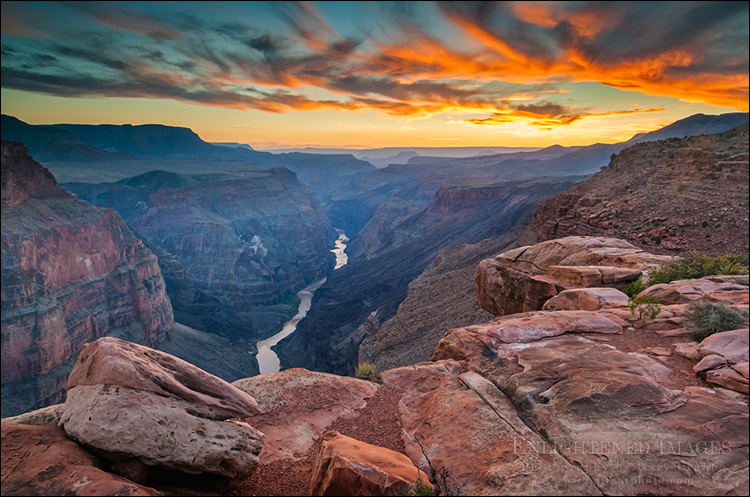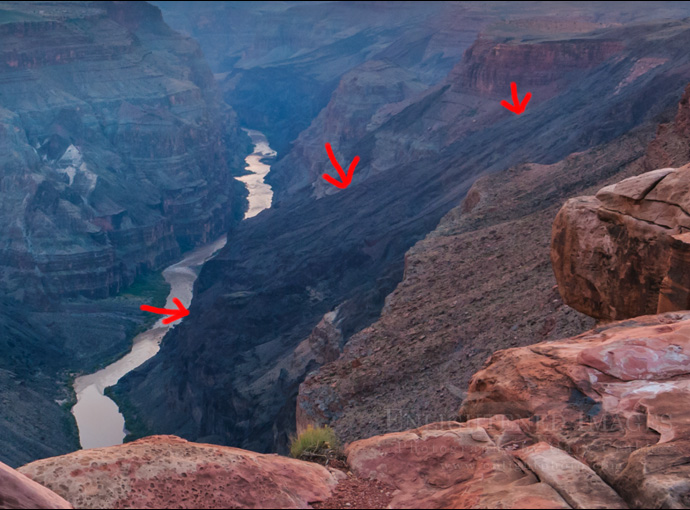Photo: Steep rugged cliffs above the Colorado River at sunset, Toroweap, Grand Canyon National Park, Arizona

When you look at images of the Grand Canyon and you have any basic sense of geology, you think about eons of huge yet subtle geological forces at work, namely the continually erosive power of water slowly carving its way through layer after layer of sedimentary rock. But you probably don’t think of volcanoes. Here in the United States, volcanoes are for places like Yellowstone, or the Cascade Range in the Pacific Northwest, with Mount Rainier and Mt. St. Helens, even here in California with Mount Lassen, Mount Shasta, and the Long Valley Caldera. But the Grand Canyon and volcanoes? Nope, this combination does not automatically compute.
When I’m hanging out in my living room working on my laptop, I may have the television turned on as background noise to the History or Science Channels, PBS, or the local news. The other day I caught an episode of How the Earth Was Made on the History Channel. I’d previously seen a great episode they had on the formation of Yosemite Valley, so I paid a little more attention than usual when I caught an episode on the formation of the Grand Canyon.
Needless to say, I was a little surprised when they started talking about lava flows at the Grand Canyon, with some surface flows dating to as recently as within the last thousand years or so. Even more surprising was when the pointed out a lava flow formation that could be seen near Toroweap on the north rim. Hey… I’ve been there; let me check my photos. So I went back into my archives and found this image from my visit in October 2006, and sure enough, right in the middle of the frame on the right side of the river, stretching all the way from near the rim to the river, was a clearly-defined black rock lava flow.

Talk about photographic Bonus Points! One of my personal favorite portfolio images also shows clear evidence of active volcanism at the Grand Canyon. Who knew? (Geologists need not respond.)
Finally, if you’ve been to Toroweap, wouldn’t you agree with me that it truly is one of the most special accessible places in the Grand Canyon?
*Environmental Side Note:* There are groups planning some massive developments at and within the Grand Canyon, including a mega-mall, and a cable-car gondola ride to the river and back. If you believe the Grand Canyon should be kept wild, please take a moment to find out more about these issues, and voice your opinion if you’re so inclined. You can check out Save the Confluence.org, read about the story in the NY Times or at NPR, or sign a petition (by June 2, 2015) at the Center for Biological Diversity.
—
![]()
If you like this post , I would greatly appreciate it if you’d consider sharing this with your friends using one of the Social Media sharing buttons located at the top of this post. You can also sign up to receive free updates by email when future posts are made to this blog.
![]()
—
Image ID#: gcnp-2087n
Click here for Information & Pricing on larger paper, canvas, or metallic prints, incl. matted & framed prints. For complete purchase options, please contact me directly.
![]()
—
Gary Crabbe is an award-winning commercial and editorial outdoor travel photographer and author based out of the San Francisco Bay Area, California. He has seven published books on California to his credit, including “Photographing California; v1-North”, which won the prestigious 2013 IBPA Benjamin Franklin Gold Medal award as Best Regional title. His client and publication credits include the National Geographic Society, the New York Times, Forbes Magazine, TIME, The North Face, Subaru, L.L. Bean, Victoria’s Secret, Sunset Magazine, The Nature Conservancy, and many more. Gary is also a photography instructor and consultant, offering both public and private photo workshops. He also works occasionally a professional freelance Photo Editor.

Great shot. I didn’t know there was volcanic activity at the Grand Canyon, but with all the volcanoes in northern Arizona I’m not surprised. I live near Sedona, and there is a lot of basal and extinct/dormant volcanoes in the area.
Have Fun,
Jeff
I’ve only ever seen that part of the Canyon from the river, but the lava flows from below are pretty spectacular, and they give the western Grand Canyon a bit of a distinct character from further upstream, a little harsher and more sinister with less of the sensuousness of the Colorado Plateau and more of the starkness of the Mojave. The first big chunk of it you see, a black column in the middle of the river called Vulcan’s Anvil, is the one-mile warning for Lava Falls, the biggest whitewater in the Canyon. And it’s mindblowing to think of liquid lava cascading off the rim of the Grand Canyon all the way to the river.